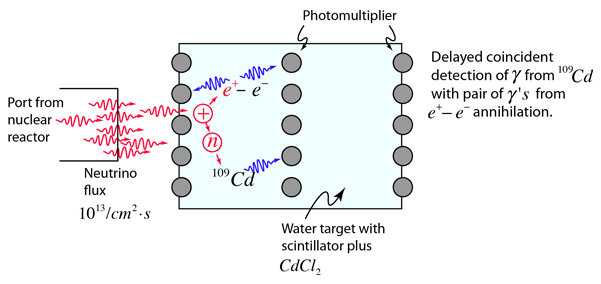Cowan and Reines Neutrino Experiment
From the study of beta decay like the decay of the neutron, it was evident in the 1930's that a third particle must be present. But since that particle, named the neutrino, had no charge and almost no mass, it was difficult to detect. In the mid 1950's, Frederick Reines and Clyde L. Cowan, Jr. came up with an experiment to verify the existence of the neutrino. It made use of the fact that nuclear reactors were expected to produce neutrino fluxes on the order of 1012-1013 neutrinos per second per cm2, far higher than any attainable flux from radioactive sources.
Neutron decay and other beta decay events produce electron antineutrinos. Those antineutrinos should interact with protons to produce neutrons and positrons.

The positrons quickly find electrons and produce two gamma rays by pair-annihilation, a very distinctive event in that you can simultaneously detect the two 0.5 MeV gammas in opposite directions. But Reines and Cowan realized that the coincident detection of the pair annihilation gammas was not quite proof of neutrino detection by this reaction. They arranged to detect the neutron from the reaction as well to confirm the occurrence of this reaction.
The gamma photons were detected by putting a scintillator material in a tank of water. The scintillator produced flashes of visible light in response to the gamma photons, and that light was detected by photomultiplier tubes. The neutrons were detected by putting cadmium chloride into the detector tank. Cadmium is a strong neutron absorber and finds use in control rods for nuclear reactors because of that. When absorbing a neutron, 108Cd produces an excited state of 109Cd which subsequently emits a gamma ray.

The experimental arrangement was such that the additional gamma from this process was detected within about 5 x 10-6 seconds after the e+-e- pair-annihilation gammas. This provided a distinctive signature for the neutrino reaction - the gamma pair in coincidence plus another gamma within 5 μs.

After a preliminary experiment at Hanford, Reines and Cowan moved the experiment to the Savannah River Plant near Augusta, Georgia where they had better shielding against cosmic rays. This shielded location was 11 m from the reactor and 12 m underground. In the 1956 experiment they used two tanks with a total of about 200 liters of water with about 40 kg of dissolved CDCl2 dissolved in it. The water tanks were sandwiched between three scintillator layers which contained 110 5-inch photomultiplier tubes. After months of data collection, they had accumulated data on about three neutrinos per hour in their detector. As additional confirmation that they were seeing neutrino events from the detection scheme described above, they shut down the reactor to show that there was a difference in the number of detected events. They had predicted a cross-section for the reaction to be about 6 x 10-44 cm2 and their measured cross-section was 6.3 x 10-44 cm2.Their results were published in 1956. Frederick Reines was honored by the Nobel Prize in 1995 for his work on neutrino physics.
Original papers:
"Detection of the Free Neutrino: A Confirmation", C. L. Cowan, Jr., F. Reines, F. B. Harrison, H. W. Kruse and A. D. McGuire, Science 124, 103 (1956).
"The Neutrino", Frederick Reines and Clyde L. Cowan, Jr., Nature 178, 446 (1956).
| Decay of the neutron |
Particle concepts
References
Rohlf
Ch. 11
| HyperPhysics***** Quantum Physics | R Nave |